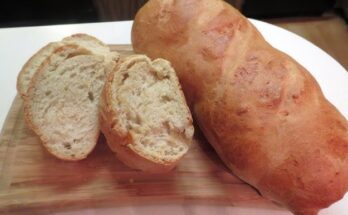Croquembouche Recipe: Imagine a towering cone of golden cream puffs, delicately laced with glistening caramel threads—it’s not a dream; it’s croquembouche, the ultimate French celebration dessert. Meaning “crunch in the mouth,” croquembouche is more than a sweet treat—it’s a show-stopping centerpiece that’s as elegant as it is indulgent.
Whether you’re planning a wedding dessert table, hosting a fancy holiday dinner, or just trying to impress your foodie friends, croquembouche delivers in both taste and wow factor. Yes, it looks complicated—but with the right ingredients, tools, and a bit of patience, you’ll be able to craft your very own towering masterpiece at home.
This guide will walk you through each step with clarity and detail, making this seemingly complex dessert completely approachable, even if you’ve never piped a pastry before. Let’s get started!
Ingredients You’ll Need
Before you dive into your croquembouche adventure, make sure you’ve got everything ready. This dessert involves three major components: choux pastry (pâte à choux), pastry cream, and caramel. Don’t skip anything—each part plays a vital role in building flavor and structure.
For the Choux Pastry:
- 1 cup water
- 1/2 cup unsalted butter (1 stick)
- 1/4 teaspoon salt
- 1 cup all-purpose flour
- 4 large eggs
These are your basic pâte à choux ingredients. When mixed correctly, they create the light, airy puffs that form the foundation of your croquembouche.
For the Pastry Cream (Crème Pâtissière):
- 2 cups whole milk
- 1/2 cup granulated sugar
- 1/4 cup cornstarch
- 4 large egg yolks
- 2 tablespoons unsalted butter
- 1 teaspoon pure vanilla extract
This rich, smooth filling is piped into the baked choux puffs to add a luxurious creamy center.
For the Caramel:
- 2 cups granulated sugar
- 1/2 cup water
- 1 tablespoon light corn syrup (optional, helps prevent crystallization)
This sticky caramel is the glue that holds the croquembouche together—and it also creates that gorgeous golden finish.
Optional Garnishes:
- Edible gold leaf
- Spun sugar
- Fresh flowers (unsprayed)
- Powdered sugar
- Ribbon for decoration
Have fun with the garnishes! These optional elements help turn your croquembouche from beautiful to breathtaking.
Tools You’ll Need
The right tools make building a croquembouche easier and safer. While some items are optional, others are essential.
Must-Have Tools:
- Saucepan (medium to large)
- Mixing bowl
- Piping bag with small round tip
- Whisk
- Wooden spoon or silicone spatula
- Baking sheet with parchment paper
- Stand mixer or hand mixer
- Candy thermometer (for caramel)
- Cooling rack
Helpful Extras:
- Croquembouche mold or cone (optional but helpful for beginners)
- Small offset spatula
- Kitchen torch (for spun sugar or flair)
- Lazy Susan (to help spin while decorating)
Having these tools on hand ensures a smooth process from prep to final presentation.
How to Make Croquembouche: Step-by-Step Guide
Now comes the fun part—actually making your croquembouche. We’ll break it down into manageable steps so you can build confidence as you go.
Step 1: Make the Choux Pastry
Begin by boiling water, butter, salt, and sugar. Once boiling, add the flour all at once and stir vigorously until the dough forms a smooth ball. Remove from heat and let it cool slightly before incorporating the eggs one at a time, mixing until glossy and pipeable.
Step 2: Bake the Puffs
Pipe small mounds of dough onto a baking sheet. Bake until the puffs are golden, crisp, and hollow inside. Proper baking ensures they won’t collapse when filled.
Step 3: Prepare the Pastry Cream
Cook a rich custard using milk, egg yolks, sugar, and cornstarch. Whisk until thick, then let it cool completely before piping it into the baked puffs.
Step 4: Fill the Cream Puffs
Use a small piping tip to fill each puff with pastry cream. Fill just until the puff feels slightly heavy—avoid overfilling.
Step 5: Make the Caramel
Cook sugar and water until it turns a deep amber. Handle with extreme caution as caramel is very hot.
Step 6: Assemble the Croquembouche
Dip each filled puff into caramel and begin stacking in a cone shape, using the caramel as edible glue.
Step 7: Add Garnishes and Decorations
Finish with spun sugar, flowers, or themed ribbons for a stunning presentation.
Tips for Success
Making a croquembouche can be intimidating, but trust me—it’s totally doable if you follow a few golden rules. Whether it’s your first time or you’re looking to perfect your technique, these tips will help guarantee success from the first puff to the final spun sugar swirl.
Plan Ahead and Stay Organized:
This dessert has multiple components, and timing is everything. Make your pastry cream a day ahead to give it time to chill. You can even bake the puffs the night before (just keep them in an airtight container at room temperature). Having all your tools and ingredients prepped before you start will save you stress later on.
Mind Your Dough Consistency:
Your choux pastry dough should be glossy and thick, but not runny. If it’s too stiff, the puffs won’t rise. If it’s too loose, they’ll collapse. Always add eggs one at a time and test the consistency before adding the next.
Watch Your Caramel Carefully:
Caramel goes from perfect to burned in seconds. Never walk away while it’s cooking. Once it turns a deep amber, remove it from the heat immediately. Keep a bowl of ice water nearby in case of burns, and use gloves when handling hot sugar.
Practice Piping:
Consistent puff size helps your tower stay balanced. Practice a few rounds of piping on parchment to get the hang of it. If your puffs are uneven, arrange the bigger ones at the bottom and smaller ones toward the top.
Use a Mold for Easy Assembly:
Especially if you’re new to croquembouche, a stainless steel cone mold wrapped in parchment paper gives you a shape to build on. You can remove the mold once your structure has cooled and hardened.
Have a Back-Up Plan:
Even experienced bakers can have caramel mishaps. Keep extra sugar and a clean saucepan on standby in case you need to make a second batch. Don’t panic—caramel is just sugar and water. You’ve got this.
Serving Suggestions
So you’ve made a croquembouche… now what? Presentation is half the fun with this dessert. Whether you’re hosting a fancy event or a holiday gathering, how you serve it adds to the wow factor.
How to Present It:
Place your croquembouche on a beautiful cake stand or platter. If it’s a wedding or elegant party, dress up the table with greenery, candles, or flowers to complement the theme. Dim the lights and let your spun sugar glisten.
Want to go even more dramatic? Add sparklers or a small LED light inside the base of the cone for a glowing effect when you serve.
When to Serve:
Croquembouche is best served within a few hours of assembly to keep that perfect crunch. It’s ideal for:
- Weddings – A classic French wedding dessert
- Holidays – Christmas, New Year’s Eve, Easter
- Birthday parties – Especially for someone who loves French pastries
- Baby or bridal showers
How to Cut and Serve:
Don’t try to slice it like a cake. Instead, let guests pull off individual cream puffs using small tongs or gloved hands. It’s interactive, fun, and surprisingly mess-free when done right.
Pair with coffee, champagne, or dessert wine for a sophisticated finale.
Nutritional Information
Let’s be real: croquembouche isn’t exactly a low-calorie dessert—but it’s meant to be an indulgent treat for special occasions.
| Nutrient | Per Puff (approx.) |
|---|---|
| Calories | 90–120 kcal |
| Total Fat | 6g |
| Saturated Fat | 3g |
| Cholesterol | 40mg |
| Sodium | 40mg |
| Carbohydrates | 9g |
| Sugars | 5g |
| Protein | 2g |
Multiply by the number of puffs you eat to get a full serving estimate. If you’re making a large croquembouche, remember this dessert is best shared!
Variations of Croquembouche
Want to add your own twist to the traditional croquembouche? You absolutely can! There are dozens of creative ways to personalize the flavor and appearance of this French classic.
Chocolate-Filled Croquembouche:
Swap the vanilla pastry cream for chocolate ganache or chocolate pastry cream. You can even drizzle melted chocolate over the final tower instead of caramel for a dramatic look and rich flavor.
Holiday Themed:
- Christmas: Use red and green ribbons, sugared cranberries, and a dusting of powdered sugar to mimic snow.
- Easter: Add pastel colors with spun sugar nests and mini chocolate eggs.
- Valentine’s Day: Add rose petals and white chocolate drizzle for a romantic flair.
Mini Croquembouche Towers:
Instead of one large cone, make mini versions for individual servings. Stack 5–7 puffs using caramel or chocolate on a cupcake liner. It’s a fun way to serve croquembouche at parties or as plated desserts.
Gluten-Free Version:
Use gluten-free flour (like a 1-to-1 baking blend) in place of all-purpose flour. The texture may vary slightly, but it still works!
Troubleshooting Common Problems
Even seasoned bakers can hit snags with croquembouche. Here are the most common issues and how to fix them.
Puffs Not Rising:
- Cause: Too much or too little egg, or undercooked dough
- Fix: Make sure your dough is smooth and glossy before piping. Bake at a high temperature (400°F) and don’t open the oven too early.
Cream Leaking Out:
- Cause: Overfilled puffs or a tear in the choux
- Fix: Pipe slowly and stop as soon as you feel resistance. Handle puffs gently.
Caramel Crystallized:
- Cause: Stirring the sugar after it’s dissolved
- Fix: Don’t stir once the sugar has melted. Add a splash of corn syrup or lemon juice to help prevent crystallization.
Tower Collapsing:
- Cause: Uneven puff size or weak caramel
- Fix: Use a mold for support, ensure caramel is tacky (not too hot or too cool), and stack evenly.
Make-Ahead Instructions
You can absolutely prep most of your croquembouche components in advance—just be smart about storage.
- Pastry Cream: Make up to 2 days ahead, store in the fridge with plastic wrap pressed to the surface.
- Choux Puffs: Bake a day in advance and store in an airtight container at room temperature.
- Caramel: Must be made just before assembly.
- Assembly: Do it the day you serve. For best crunch, assemble no more than 3–4 hours before your event.
Pro Tip: If storing cream-filled puffs before assembling, keep them in the fridge in a single layer so they don’t collapse.
Storage and Leftovers
Croquembouche doesn’t store well once assembled (the caramel softens and the puffs get soggy), but here’s how to make the most of your leftovers.
- Fridge: Store in an airtight container for up to 2 days. The texture won’t be the same, but it’s still tasty.
- Freezer: You can freeze unfilled choux puffs for up to a month. Re-crisp in the oven before filling.
- Reheating: Don’t reheat a fully assembled croquembouche, but you can warm the puffs (before filling) at 300°F for 5–8 minutes to refresh them.
Fun Facts About Croquembouche
Croquembouche isn’t just delicious—it’s got a pretty fascinating backstory and cultural significance that makes it even more special to serve.
It Dates Back to the 1700s:
Croquembouche originated in France and was first described in a cookbook by Antonin Carême, one of the first celebrity chefs in the world. Known as the “King of Chefs,” Carême was all about culinary artistry and grandeur, and croquembouche definitely fits that bill.
Traditional Wedding Dessert:
In France, croquembouche is a classic wedding dessert. Instead of a tiered cake, couples often opt for this caramel-drizzled tower. It symbolizes prosperity and joy—pretty fitting for a marriage celebration, right?
The Name Means ‘Crunch in the Mouth’:
“Croquembouche” literally translates to “crunch in the mouth”. This refers to the caramel coating that hardens on the outside of the puffs, offering a satisfying contrast to the soft, creamy interior. It’s a full sensory experience: crispy, creamy, sweet, and buttery all in one bite.
Popular with Celebrity Chefs:
You’ve probably seen croquembouche featured on shows like The Great British Bake Off, MasterChef, and even Top Chef. Why? Because it’s the ultimate test of a baker’s skills—technique, patience, and presentation all rolled into one.
A Favorite During the Holidays:
In many French households, croquembouche is a centerpiece dessert during Christmas or New Year’s Eve. With its towering structure and golden sheen, it’s the perfect dessert to impress during festive seasons.
So when you make croquembouche, you’re not just baking—you’re tapping into centuries of culinary tradition. That’s something to be proud of!
FAQs about Croquembouche Recipe
1. Can I make croquembouche without a mold?
Yes! While a metal cone mold helps with shaping, it’s totally possible to build freehand. Start with a strong base layer of cream puffs in a tight circle and build upward, securing each layer with caramel. Just be careful and take your time.
2. What if I don’t have a piping bag?
No problem. You can use a ziplock bag with the corner snipped off for both piping dough and filling the puffs. It won’t be as precise, but it gets the job done—just be sure the hole isn’t too big or too small.
3. Is it okay to use store-bought pastry cream?
You can, but homemade pastry cream tastes way better and has a thicker consistency that holds up better in puffs. If you’re in a rush, go for a high-quality vanilla pudding or custard and chill it well before using.
4. How long does croquembouche stay crispy?
Once assembled, croquembouche is best enjoyed within 4–6 hours. After that, the caramel starts to absorb moisture and the puffs soften. If you need to prep ahead, keep the components separate until you’re ready to build.
5. Can I make a gluten-free version?
Absolutely! Swap the all-purpose flour for a 1:1 gluten-free baking blend. The texture will be slightly different but still delicious. Make sure your pastry cream and caramel are gluten-free too, and you’re good to go.
Conclusion
From the crisp, airy puffs to the silky pastry cream and the golden caramel that ties it all together, every part of this dessert is a labor of love. It’s not just food—it’s a centerpiece, a conversation starter, a show of effort and celebration. Whether you’re crafting one for a wedding, a holiday, or just to challenge yourself in the kitchen, croquembouche is a dessert that wows every time.
Take your time, follow the steps, and don’t be afraid to make it your own with flavors, decorations, or presentation. Remember, the first time might be messy, but the result will still be gorgeous—and incredibly delicious.
Ready to impress your guests with your new pastry chef skills? Then tie that apron, melt that sugar, and start stacking!



